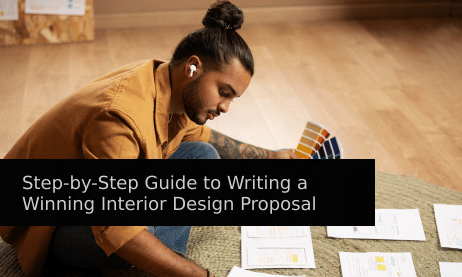Are you an interior designer looking to win more projects and impress potential clients? Writing a convincing interior design proposal is key to showcasing your skills and securing new opportunities. In this step-by-step guide, we’ll walk you through the process of creating an interior design proposal that stands out from the competition and leaves a lasting impression on your clients.
What’s an Interior Design Proposal?
An interior design proposal is a document created by a designer to convince a potential client to hire them for a specific project. It acts as a roadmap, outlining the designer’s vision, the services they’ll provide, the project timeline, and the associated costs. Essentially, it’s a persuasive argument that explains why the designer is the best fit to transform the client’s space into their dream reality.

Here’s a breakdown of what an interior design proposal typically includes:
- Client background and project understanding: A summary demonstrating the designer’s grasp of the client’s needs, preferences, and budget.
- Design vision and approach: A clear explanation of the designer’s plan for the space, including the proposed style, functionality, and how it aligns with the client’s vision.
- Scope of services: A detailed list of the specific design services the designer will provide, such as space planning, furniture selection, color consultations, and project management.
- Project timeline: A realistic breakdown of the project’s expected duration, with key milestones and completion dates for each stage.
- Budget and fees: A transparent explanation of the designer’s fees, whether hourly, fixed, or tiered, along with justifications for their rates.
- Next steps: A clear call to action outlining how the client can move forward if they’d like to hire the designer.
Step-by-Step Guide to Writing an Interior Design Proposal That Stands Out
I. Pre-Writing: Understanding Your Client
This initial stage is important for writing a proposal that resonates with your client. Here’s how to dig deep and gather the information you need:
- Conduct a Client Consultation: Schedule a meeting (in-person or virtual) to discuss the project in detail. Ask open-ended questions to understand their vision for the space. What is the purpose of the design? What feeling are they hoping to create? What are their lifestyle needs?
- Needs Assessment: Pay close attention to their responses and take notes. Look beyond the aesthetic desires and uncover the underlying functional needs. For example, a client might say they want a “modern living room,” but their needs might reveal a need for ample seating for entertaining or a designated workspace for hobbies.

Gather Specific Information on:
- Budget: Get a clear understanding of their budget for the project. This will guide your material and furniture recommendations.
- Timeline: Discuss their desired timeframe for project completion.
- Style Preferences: Explore their design tastes. Do they have inspiration photos or specific styles they’re drawn to (modern, minimalist, traditional, etc.)?
- Space Functionality: Evaluate the space itself. Measure the room and take note of architectural features, existing fixtures, and any limitations.
Additional Tips
- Active Listening: Pay attention to both verbal and nonverbal cues during the consultation.
- Site Visit: If possible, schedule a site visit to get a first-hand feel for the space and its potential.
- Questionnaires: Consider creating a pre-consultation questionnaire to gather preliminary information and streamline the meeting.
II. Writing a Compelling Proposal: Make a Lasting First Impression
- Cover Page: This is your chance to make a strong first impression. Here’s what to include:
- Your Logo: A professional logo with a clean design reinforces your brand identity.
- Contact Information: Make it easy for the client to reach you by including your phone number, email address, and website (if applicable).
- Project Title: Clearly state the project name (e.g., [Client Name] Living Room Redesign).
- Visually Appealing Image: Consider including a high-quality image that reflects your design aesthetic or hints at the project’s potential. This could be an example of your past work or an inspirational image that aligns with the client’s vision.
- Executive Summary: This is your elevator pitch, a concise overview that captures the essence of your proposal. Here’s how to structure it:
- Introduce Yourself: Briefly introduce yourself as the designer and your design firm (if applicable).
- Highlight Your Design Philosophy: In a sentence or two, express your core design principles and what sets your approach apart.
- Align with Client Needs: Connect your design philosophy to the client’s vision. Explain how your expertise can translate their desires into a functional and beautiful space.
Example of a Good Executive Summary:
“Sarah Jones Interiors creates timeless and functional spaces that reflect our clients’ unique personalities. We are passionate about using sustainable materials and maximizing the potential of every room. For your living room redesign, we propose a welcoming and modern design that caters to your love of entertaining and creates a comfortable haven for relaxation.”
III. Showcasing Your Expertise
- Design Concept & Vision: This is the heart of your business proposal, where you explain your design approach in detail. Here’s what to include:
- Explain Your Approach: Clearly outline the design concept you propose for the space. Consider factors like style, functionality, and overall ambiance.
- Align with Client Needs: Demonstrate how your design concept directly addresses the client’s needs and preferences discussed during the consultation stage.
- Focus on Functionality: Don’t just focus on aesthetics. Explain how your design choices will enhance the functionality of the space. For example, if the client needs a workspace in their living room, describe how you’ll incorporate a designated work area that seamlessly integrates with the overall design.
IV. Detailing the Project: A Roadmap to Success
In this section, you’ll provide a clear roadmap outlining the project’s specifics and how you’ll navigate it from start to finish.
- Scope of Services: Here, transparency is key. Clearly outline the exact design services you’ll be providing for the project. This might include:
- Space planning: Explain how you’ll optimize the layout of the space to maximize functionality and flow.
- Furniture selection: Will you source furniture, or will the client be responsible for purchasing pieces you recommend?
- Material and finish selection: Do you include selecting materials for flooring, countertops, paint colors, etc.?
- Lighting design: Will you develop a lighting plan to create the desired ambiance?
- Construction documentation: Will you provide drawings or specifications needed for any construction work?
- Project management: Will you oversee the project execution, including coordinating with contractors and vendors?
Be sure to tailor the scope of services to the specific project and the client’s needs. Some clients might prefer a full-service approach, while others might prefer a more limited consultation.
- Project Timeline: Provide a realistic timeline for the project, outlining key milestones and estimated completion dates for each stage. Here’s what to include:
- Pre-Design Phase: Include the timeframe for the initial consultation, site visit (if applicable), and development of the design concept.
- Design Development: Outline the estimated duration for creating mood boards, finalizing plans, and selecting materials and finishes.
- Procurement: Factor in the lead time for ordering furniture, materials, and any custom pieces.
- Construction (if applicable): If your services include project management, estimate the construction timeframe based on the scope of work.
- Installation and Completion: Include the estimated timeframe for furniture installation, decor placement, and final styling touches.
Pro Tip: Involve the client in the timeline discussion. Be upfront about potential delays due to material lead times or permitting processes.
Check out this Interior Design Proposal template to get you started on your proposal writing
V. Highlighting Your Value: Why You’re the Perfect Choice
In this section, you’ll convince the client that you’re not just another designer – you’re the ideal partner to bring their vision to life. Here’s how to showcase your value:
- Material & Finish Selection: Expertise Beyond Aesthetics
Don’t just present materials and finishes based on aesthetics alone. Demonstrate your expertise by explaining your choices in the context of the project’s requirements:
Align with Design Concept: Explain how the proposed materials and finishes complement the overall design concept and create the desired ambiance.
Durability & Functionality: Consider the space’s purpose and traffic flow. Recommend materials that are suitable for the intended use and will withstand everyday wear and tear.
Budget Considerations: Be mindful of the client’s budget. Offer a range of options that cater to their needs while staying within their financial constraints.
- Unique Value Proposition: Stand Out from the Crowd
Every designer has something unique to offer. This is your chance to shine a spotlight on what sets you apart from the competition:
Experience & Expertise: Highlight your experience and expertise in specific design styles or project types relevant to the client’s needs.
Sustainable Design Practices: Do you prioritize eco-friendly materials and sustainable design practices? If so, showcase your commitment to environmental responsibility.
Exceptional Communication & Client Service: Emphasize your strong communication skills and dedication to providing exceptional customer service.
Network of Trusted Vendors & Contractors: Do you have a network of reliable vendors and contractors who can ensure high-quality project execution? Mention this to instill confidence in the client.
Pro Tip: Tailor your unique value proposition to each client. If a client expressed a concern about eco-friendliness, highlight your sustainable design practices.
VI. Nailing the Business Side: Transparency Builds Trust
While design is at the heart of your proposal, the financial aspects are equally important. This section establishes clear expectations regarding fees, payments, and terms, fostering trust and a smooth client relationship.
- Fee Structure: Laying Out the Costs
Be upfront and transparent about your fees. Here’s how to present your fee structure:
Fee Type: Clearly outline whether you charge an hourly rate, a fixed fee for the entire project, or a tiered fee structure based on the scope of services.
Justification for Fees: Briefly explain the rationale behind your fees. Consider highlighting your experience, expertise, and the value you bring to the project.
Breakdown (Optional): For complex projects with a tiered fee structure, consider providing a breakdown of fees associated with each stage (e.g., design development, procurement, project management).
- Payment Schedule: A Roadmap for Financial Flow
Outline a clear and realistic payment schedule that aligns with the project timeline. Here’s what to include:
Deposit: Specify the required deposit amount upfront to secure your services.
Milestone Payments: Establish payment milestones tied to key stages of the project. This ensures the client is comfortable with the progress before releasing further funds.
Client Approval: Emphasize that you’ll seek client approval for major decisions (e.g., material selections) before proceeding, ensuring they’re comfortable with any associated costs.
- Terms & Conditions: Setting Expectations for Collaboration
Include standard business terms to protect yourself and manage client expectations:
Cancellation Policy: Outline the terms and potential fees associated with project cancellation at different stages.
Revision Limits: Specify a reasonable number of design revisions included within your fee. Clients may request additional revisions, but outline that these will be subject to additional fees.
Liability: Include standard industry disclaimers regarding liability for damages or unforeseen circumstances.
Pro Tip: Be open to discussing the financial aspects with the client. Address any questions or concerns they might have to ensure everyone is on the same page.
VII. Next Steps and Closing: Securing the Project
Now that you’ve showcased your design expertise and value proposition, it’s time to guide the client towards the next step – hiring you. Here’s how to write a good closing:
- Call to Action
Make it easy for the client to move forward with the project. Here’s how:
State Your Availability: Briefly mention your availability to start the project and discuss your schedule.
Preferred Method of Contact: Clearly state your preferred method for the client to reach you, whether by phone, email, or a scheduling link.
Invitation for Further Discussion: Express your openness to discuss their questions or concerns and answer any final inquiries they might have.
Bonus Tip: Proofread your proposal meticulously before sending it to the client. A polished and error-free document reflects your professionalism and attention to detail.

Additional Tips for Writing a Winning Interior Design Proposal
While the core structure of your proposal is important, these additional tips will ensure your document is polished, impactful, and leaves a lasting impression on potential clients:
- Visually Appealing Design: People respond well to aesthetics. Don’t underestimate the power of visual design in your proposal:
- High-Quality Images: Use clear, high-resolution images throughout your proposal. This includes images of your past work, mood boards you’ve created, and any inspirational sources that inform your design vision.
- Compelling Graphics: Consider incorporating charts, graphs, or other visuals to represent the project timeline, budget breakdown, or space planning concepts.
- Well-Formatted Layout: Maintain a clean and organized layout throughout your proposal. Use consistent fonts, spacing, and headings for easy readability.
- Proofread and Edit Meticulously: There’s nothing worse than a proposal riddled with typos or grammatical errors. Before submitting your proposal, take the time to:
- Proofread Thoroughly: Proofread the document yourself for any typos, grammatical mistakes, or spelling errors.
- Consider Getting a Second Pair of Eyes: Ask a trusted colleague or friend to proofread your proposal for an extra layer of assurance.
- Tailored Content is Key: A generic proposal won’t impress anyone. Personalize each proposal to the specific client and project:
- Address Their Needs: Throughout the proposal, demonstrate how your design solutions directly address the client’s needs, preferences, and budget discussed during the consultation.
- Highlight Relevant Experience: If you have experience designing similar spaces or working with clients with similar needs, highlight that experience in your proposal.
- Showcase Project Understanding: Use specific details from your client conversations to show you were paying attention and understand their vision.

Conclusion
Writing an interior design proposal that lands you the job requires meticulous planning and attention to detail. By following the step-by-step guide provided, you can ensure that your proposal not only meets but exceeds client expectations.
To get started on your proposal writing journey consider using a proposal writing software like Prospero. Sign up and create your first proposal by clicking this link.




